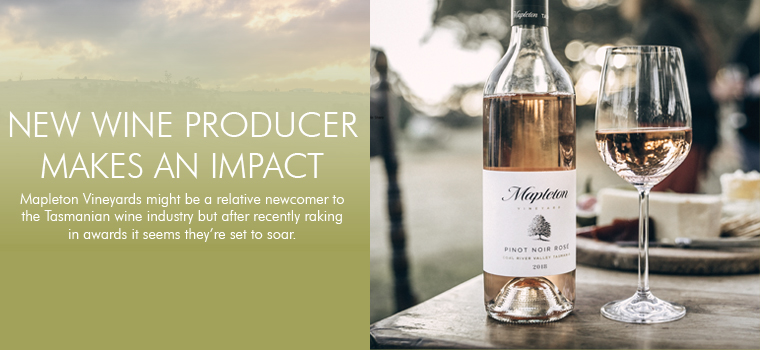Mapleton Vineyards might be a relative newcomer to the Tasmanian wine industry but after recently raking in awards it seems they’re set to soar.
"Paul and Denis often discussed the idea of planting a vineyard on Mapleton, given its ideal aspects of gently rolling northern facing banks and rich dolomitic soils, but it was not until 2014 that thoughts became action."
WINSOR DOBBIN
FOR a producer that only released its first wines three years ago, Mapleton Vineyards in Tasmania’s Coal River Valley is rapidly building an impressive reputation.
With gold medals from the Tasmanian Wine Show followed by national recognition from Winestate, vigneron Paul Laing is benefitting from the fruits of his hard labour when the vines were planted.
Mapleton, at Tea Tree, north of Hobart, only makes around 1,000 cases, but joins producers like Mewstone, Sailor Seeks Horse, Anime and Altaness as the latest wave of innovative Tasmanian producers.
Hobart-born Laing and his parents, businessman Denis and Kathryn Laing, purchased Mapleton in 2004 but it sat idle for several years while Paul built a career on the land dealing with both livestock and cropping in the state’s Midlands.
Situated near the hamlet of Tea Tree in the Coal River Valley , Mapleton is one of three vineyards on which grapes are grown for the brand: the others being Woodlands and Lynwood.
Paul and Denis often discussed the idea of planting a vineyard on Mapleton, given its ideal aspects of gently rolling northern facing banks and rich dolomitic soils, but it was not until 2014 that thoughts became action.
The first planting of one hectare of pinot noir was followed by a further four hectares a year later.
Woodlands has approximately three of its hectares under vines, the first of which are plantings dating back to 1992. But when the Laing family acquired the property the vines had been in a serious state of neglect for many years.
“We went through it with a chainsaw and cut all the vines off at ground level,” Paul Laing recalls. “We then took the property’s viticulture back to scratch.”
Today, after several years of hard work, those vines are producing top-notch pinot noir, chardonnay, and a small amount of cabernet sauvignon.
Lynwood was purchased six months after Woodlands, and Kathryn and Denis now call that property home. It has four hectares of vines including pinot noir, chardonnay and riesling, all planted in 2003.
These vines had also been struggling for some time to produce fruit and only became productive in 2018. The family now has a total of 12 hectares of vines under development. The current range includes 2018 riesling, chardonnay and pinot noir rosé, and 2019 pinot noir and pinot noir rosé.
“We are very focused on making sure that we only release our wines when they are ready to be enjoyed at their best,” says Paul Laing. “As a young brand we cannot afford to release wines that are not top-notch and ready to be enjoyed.
”It is important to us as a relatively new business, that we go about things in the right way.”
The Laings have wine in their blood. Paul is the nephew of wine educator and Tasmanian Wine Show president Phil Laing, a leading figure on the island.
While most Tasmanian producers concentrate on pinot noir and chardonnay, as well as sparkling wines, Mapleton has enjoyed early success with riesling and rosé, which is made from a blend of 115 and German Marienfield clones.
“In 10 years or so the vines that produce the fruit for the rosé will be used for table pinot noir but they are excelling as young vines at producing vibrant fruit for the rosé,” says Paul Laing, who cultivates the vines with the help of just one full-time employee, a long-time friend.
For such a young producer, the impact of Covid-19 has been difficult, but Mapleton has now taken on a distributor to help boost sales that have initially been “to family and friends and through our mailing list”.
“It has been a very steep learning curve but the fact we have been getting early recognition for our wines has certainly helped.
”It took us around 15 years to get around to doing things properly, so the response has been gratifying. To be recognised by a national publication like Winestate indicates to us that we are doing things in the right way and moving in the right direction.
”There is a lot of potential in Tasmania and it is an exciting time to be involved in the wine industry.”
The winery has been supported by local retailers including Gasworks in Hobart and the Pinot Shop in Launceston.
Mapleton, like many Tasmanian boutique producers, still operates on a tiny scale. Current production is around a minuscule 1,000 cases annually.
There are several producers in the Coal River Valley – 20 minutes north-east of Hobart – with similar production.
Over the past two to three decades, the beautiful and historic township of Richmond and the Coal River Valley have become well known on a national level for their award-winning wineries.
These vineyards are fortunate enough to have cool-climate conditions which have been compared to regions such as Burgundy in France.
The Coal River Valley was one of the earliest areas settled by the first British with Richmond dating back to 1823, when a bridge across the Coal River was built.
The name Coal River comes from the abundant natural source of coal in the area. The first British settlers used the valley as a mixture of grazing, pastureland and crop growing.
Today the region is home to several leading wine producers with a national profile and history of success on the national stage including Stoney Vineyard/Domaine A, Frogmore Creek, Pooley’s and Tolpuddle and it seems Mapleton Vineyard is set to join their success.
For details and orders visit www.mapletonvineyard.com.au

